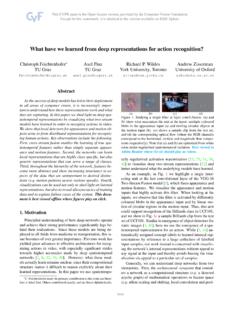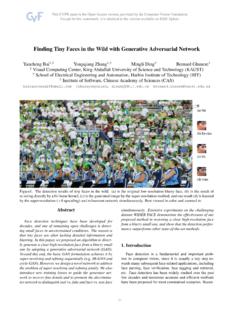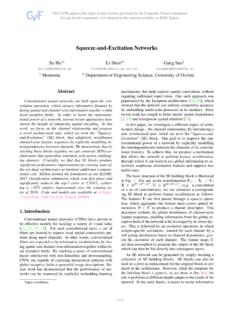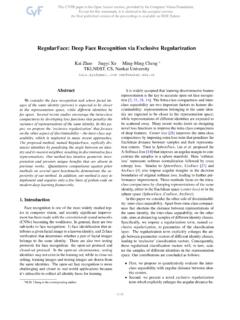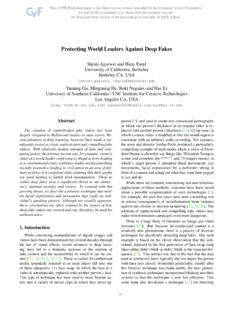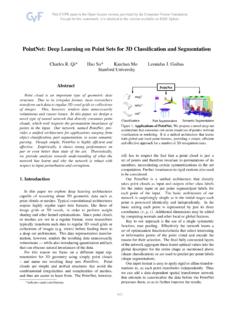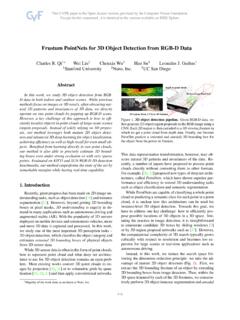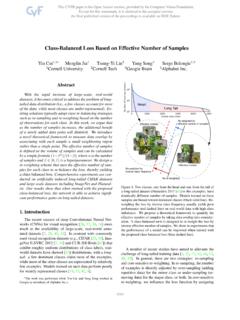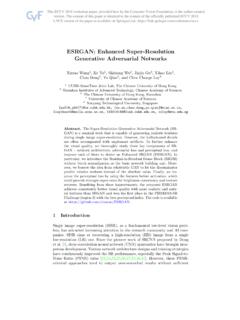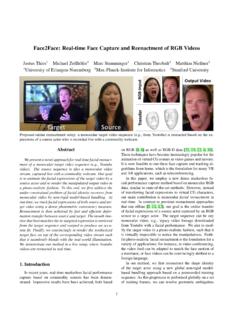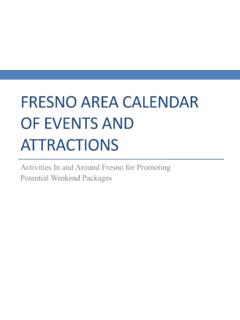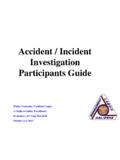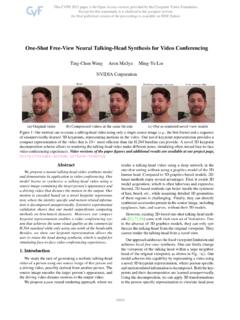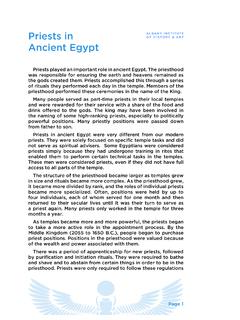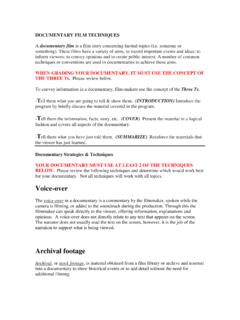Transcription of FaceForensics++: Learning to Detect Manipulated Facial …
1 faceforensics ++: Learning to Detect Manipulated Facial ImagesAndreas R ossler1 Davide Cozzolino2 Luisa Verdoliva2 Christian Riess3 Justus Thies1 Matthias Nie ner11 Technical University of Munich2 University Federico II of Naples3 University of Erlangen-NurembergFigure 1: faceforensics ++is a dataset of Facial forgeries that enables researchers to train deep- Learning -based approachesin a supervised fashion. The dataset contains manipulations created with four state-of-the-art methods, namely,Face2 Face,FaceSwap,DeepFakes, rapid progress in synthetic image generation andmanipulation has now come to a point where it raises signif-icant concerns for the implications towards society. At best,this leads to a loss of trust in digital content, but could po-tentially cause further harm by spreading false informationor fake news. This paper examines the realism of state-of-the-art image manipulations, and how difficult it is to detectthem, either automatically or by standardize the evaluation of detection methods, wepropose an automated benchmark for Facial manipulationdetection1.
2 In particular, the benchmark is based on Deep-Fakes [1], Face2 Face [56], FaceSwap [2] and NeuralTex-tures [54] as prominent representatives for Facial manipula-tions at random compression level and size. The benchmarkis publicly available2and contains a hidden test set as wellas a database of Manipulated images. Thisdataset is over an order of magnitude larger than compara-ble, publicly available, forgery datasets. Based on this data,we performed a thorough analysis of data-driven forgerydetectors. We show that the use of additional domain-specific knowledge improves forgery detection to unprece-dented accuracy, even in the presence of strong compres-sion, and clearly outperforms human IntroductionManipulation of visual content has now become ubiqui-tous, and one of the most critical topics in our digital so-ciety. For instance,DeepFakes[1] has shown how com-puter graphics and visualization techniques can be used todefame persons by replacing their face by the face of a dif-ferent person.
3 Faces are of special interest to current manip-ulation methods for various reasons: firstly, the reconstruc-tion and tracking of human faces is a well-examined fieldin computer vision [64], which is the foundation of theseediting approaches. Secondly, faces play a central role inhuman communication, as the face of a person can empha-size a message or it can even convey a message in its ownright [27].Current Facial manipulation methods can be separatedinto two categories: Facial expression manipulation and fa-cial identity manipulation (seeFig. 2). One of the mostprominent Facial expression manipulation techniques is themethod of Thies et al. [56] calledFace2 Face. It enables thetransfer of Facial expressions of one person to another per-son in real time using only commodity hardware. Follow-upwork such as Synthesizing Obama [52] is able to animatethe face of a person based on an audio input 2: Advances in the digitization of human faces have become the basis for modern Facial image editing tools.
4 Theediting tools can be split in two main categories: identity modification and expression modification. Aside from manuallyediting the face using tools such as Photoshop, many automatic approaches have been proposed in the last few years. The mostprominent and widespread identity editing technique is face swapping, which has gained significant popularity as lightweightsystems are now capable of running on mobile phones. Additionally, Facial reenactment techniques are now available, whichalter the expressions of a person by transferring the expressions of a source person to the manipulation is the second category of facialforgeries. Instead of changing expressions, these methodsreplace the face of a person with the face of another per-son. This category is known as face swapping. It becamepopular with wide-spread consumer-level applications performs face swapping, but viadeep Learning . While face swapping based on simple com-puter graphics techniques can run in real time,DeepFakesneed to be trained for each pair of videos, which is a time-consuming this work, we show that we can automatically and re-liably Detect such manipulations, and thereby outperformhuman observers by a significant margin.
5 We leverage re-cent advances in deep Learning , in particular, the ability tolearn extremely powerful image features with convolutionalneural networks (CNNs). We tackle the detection problemby training a neural network in a supervised fashion. Tothis end, we generate a large-scale dataset of manipulationsbased on the classical computer graphics-based methodsFace2 Face[56] andFaceSwap[2] as well as the Learning -based approachesDeepFakes[1] andNeuralTextures[54].As the digital media forensics field lacks a benchmarkfor forgery detection, we propose an automated benchmarkthat considers the four manipulation methods in a realisticscenario, , with random compression and randomdimensions. Using this benchmark, we evaluate the currentstate-of-the-art detection methods as well as our forgerydetection pipeline that considers the restricted field of facialmanipulation paper makes the following contributions: an automated benchmark for Facial manipulation de-tection under random compression for a standardizedcomparison, including a human baseline, a novel large-scale dataset of Manipulated Facial im-agery composed of more images from1,000 videos with pristine ( , real) sources and tar-get ground truth to enable supervised Learning , an extensive evaluation of state-of-the-art hand-craftedand learned forgery detectors in various scenarios, a state-of-the-art forgery detection method tailored tofacial Related WorkThe paper intersects several fields in computer vision anddigital multimedia forensics.
6 We cover the most importantrelated papers in the following Manipulation Methods:In the last two decades, in-terest in virtual face manipulation has rapidly increased. Acomprehensive state-of-the-art report has been published byZollh oferet al.[64]. In particular, Bregleret al.[12] pre-sented an image-based approach called Video Rewrite to au-tomatically create a new video of a person with generatedmouth movements. With Video Face Replacement [19],Daleet one of the first automatic face swapmethods. Using single-camera videos, they reconstruct a3D model of both faces and exploit the corresponding 3 Dgeometry to warp the source face to the target face. Gar-ridoet al.[28] presented a similar system that replaces theface of an actor while preserving the original [29] uses high-quality 3D face capturing techniquesto photo-realistically alter the face of an actor to match themouth movements of a dubber. Thieset al.
7 [55] demon-strated the first real-time expression transfer for Facial reen-actment. Based on a consumer level RGB-D camera, theyreconstruct and track a 3D model of the source and thetarget actor. The tracked deformations of the source faceare applied to the target face model. As a final step, theyblend the altered face on top of the original target , proposed by Thieset al.[56], is an advanced2real-time Facial reenactment system, capable of altering fa-cial movements in commodity video streams, , videosfrom the internet. They combine 3D model reconstructionand image-based rendering techniques to generate their out-put. The same principle can be also applied in Virtual Real-ity in combination with eye-tracking and reenactment [57]or be extended to the full body [58]. Kimet al.[38] learnan image-to-image translation network to convert computergraphic renderings of faces to real images. Instead of a pureimage-to-image translation network, NeuralTextures [54]optimizes a neural texture in conjunction with a renderingnetwork to compute the reenactment result.
8 In compari-son to Deep Video Portraits [38], it shows sharper results,especially, in the mouth region. Suwajanakornet al.[52]learned the mapping between audio and lip motions, whiletheir compositing approach builds on similar techniques toFace2 Face [56]. Averbuch-Eloret al.[7] present a reen-actment method, Bringing Portraits to Life, which employs2D warps to deform the image to match the expressions of asource actor. They also compare to the Face2 Face techniqueand achieve similar , several face image synthesis approaches us-ing deep Learning techniques have been proposed. Luetal.[45] provide an overview. Generative adversarial net-works (GANs) are used to apply Face Aging [6], to gener-ate new viewpoints [33], or to alter face attributes like skincolor [44]. Deep Feature Interpolation [59] shows impres-sive results on altering face attributes like age, mustache,smiling etc. Similar results of attribute interpolations areachieved by Fader Networks [41].
9 Most of these deep learn-ing based image synthesis techniques suffer from low imageresolutions. Recently, Karraset al.[36] have improved theimage quality using progressive growing of GANs, produc-ing high-quality synthesis of Forensics:Multimedia forensics aims to en-sure authenticity, origin, and provenance of an image orvideo without the help of an embedded security on integrity, early methods are driven by hand-crafted features that capture expected statistical or physics-based artifacts that occur during image formation. Surveyson these methods can be found in [25,51]. More recent lit-erature concentrates on CNN-based solutions, through bothsupervised and unsupervised Learning [9,16,11,8,34,63].For videos, the main body of work focuses on detecting ma-nipulations that can be created with relatively low effort,such as dropped or duplicated frames [60,30,43], varyinginterpolation types [24], copy-move manipulations [10,20],or chroma-key compositions [46].
10 Several other works explicitly refer to detecting manip-ulations related to faces, such as distinguishing computergenerated faces from natural ones [21,14,49], morphedfaces [48], face splicing [23,22], face swapping [62,37]and DeepFakes [4,42,32]. For face manipulation detec-tion, some approaches exploit specific artifacts arising fromthe synthesis process, such as eye blinking [42], or color,texture and shape cues [23,22]. Other works are more gen-eral and propose a deep network trained to capture the sub-tle inconsistencies arising from low-level and/or high levelfeatures [48,62,37,4,32]. These approaches show im-pressive results, however robustness issues often remain un-addressed, although they are of paramount importance forpractical applications. For example, operations like com-pression and resizing are known for laundering manipula-tion traces from the data. In real-world scenarios, thesebasic operations are standard when images and videos arefor example uploaded to social media, which is one of themost important application field for forensic analysis.
